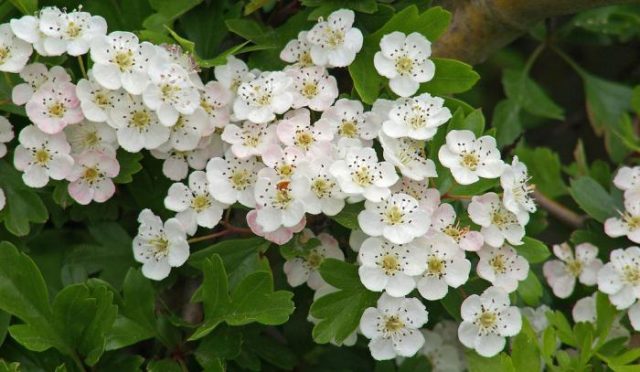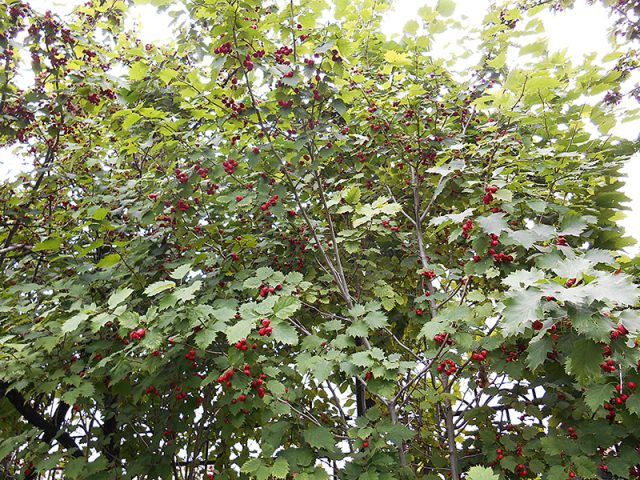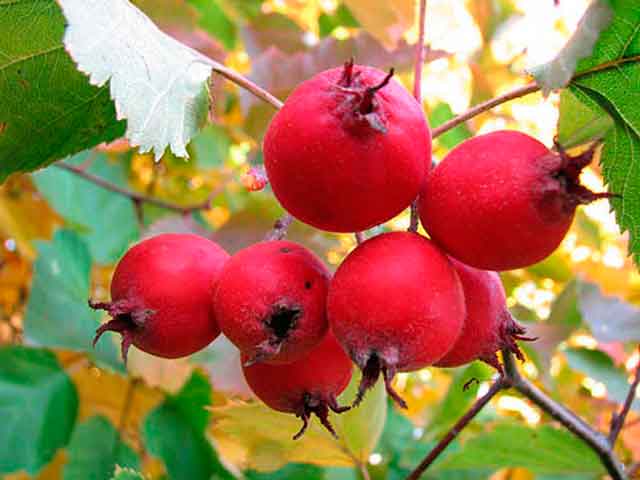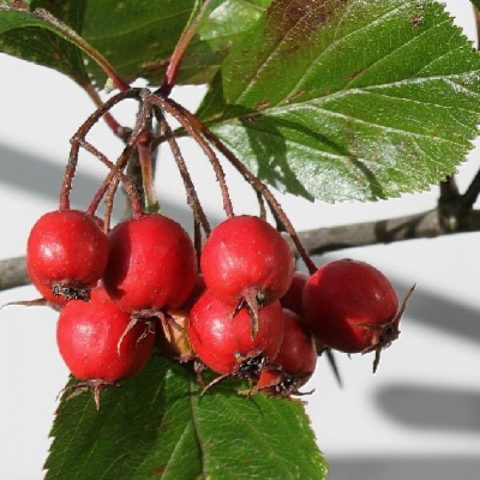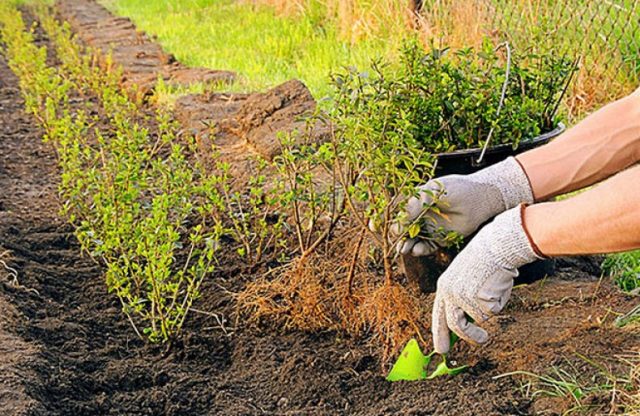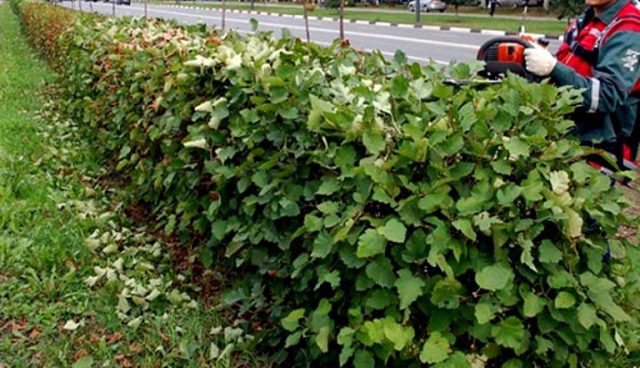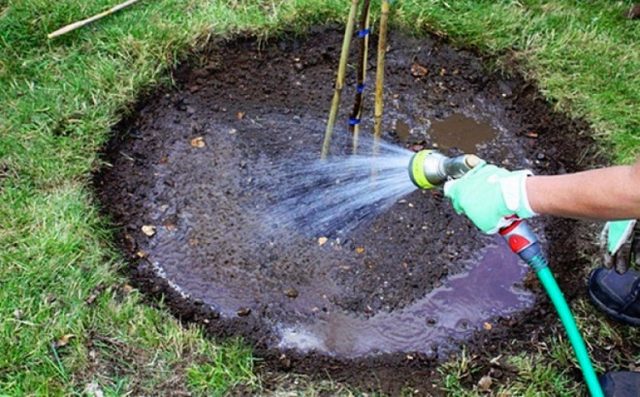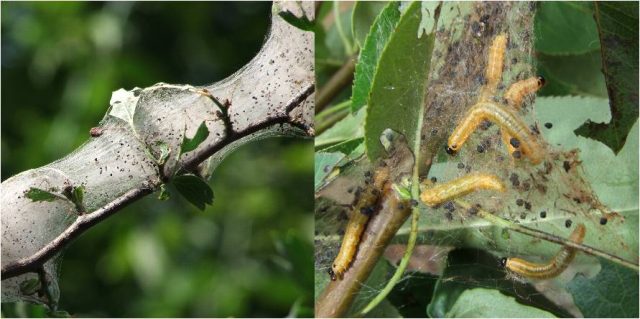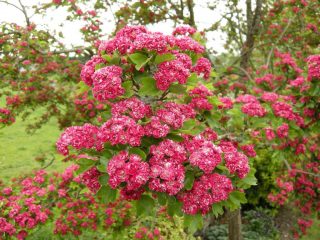Content
- 1 Hawthorn: tree or shrub
- 2 Types of hawthorn common in Russia
- 2.1 Altaic
- 2.2 Arnold
- 2.3 Fan-shaped or fan-shaped
- 2.4 Daursky
- 2.5 Douglas
- 2.6 Yellow
- 2.7 Green-meat
- 2.8 Spiny or Regular
- 2.9 Blood red or Siberian
- 2.10 Crimean
- 2.11 Round-leaved
- 2.12 Large-anthered or large-spined
- 2.13 Maksimovich
- 2.14 Soft
- 2.15 Soft or Semi-soft
- 2.16 Single-pistillate or Single-stone
- 2.17 Pinnate or Chinese
- 2.18 Pontic
- 2.19 Poyarkova
- 2.20 Spot
- 2.21 Shportsevy
- 3 Hawthorn in the garden: pros and cons
- 4 How to plant and care for hawthorn
- 4.1 When to plant hawthorn: spring or autumn
- 4.2 Where to plant hawthorn on the site
- 4.3 Selection and preparation of hawthorn seedlings
- 4.4 At what distance should you plant hawthorn?
- 4.5 Landing algorithm
- 4.6 How to replant hawthorn
- 4.7 Hawthorn care
- 4.8 Pruning hawthorn in spring and autumn
- 4.9 How to fertilize hawthorn
- 4.10 Watering, mulching
- 4.11 Preparing for winter
- 5 For what year after planting does hawthorn bear fruit?
- 6 Why hawthorn does not bear fruit: possible reasons
- 7 Hawthorn diseases: photos and fight against them
- 8 Conclusion
Growing and caring for hawthorn of any type is so simple that it can be safely planted in areas that are rarely visited. At the same time, the culture will still look attractive. Hawthorn is beautiful from spring to late autumn; it is grown as an ornamental plant.Medicinal properties are recognized by official medicine; berries and flowers are widely used in the treatment of heart diseases and as a sedative. Hawthorn fruits are edible. Particularly tasty and large berries ripen in garden varieties and North American species.
Hawthorn: tree or shrub
The genus Hawthorn (Crataegus) belongs to the Rosaceae family and is a deciduous (rarely semi-evergreen) small tree or large shrub. The culture is widespread in the temperate zone of the Northern Hemisphere, its range extends from 30⁰ to 60⁰. According to some sources, there are 231 species of hawthorn, according to others – 380. The average lifespan of a plant is 200-300 years, but there are specimens that are more than four centuries old.
The crop grows in places at least slightly illuminated by the sun - on screes, forest edges, clearings, clearings. Hawthorn of various types is found in open forests and bushes. It will not be able to survive in the dense shade of densely located trees. The topography and composition of the soil have little effect on hawthorn.
Most often, the crop grows as a low tree 3-5 m high, often forming several trunks about 10 cm in diameter, which makes it look like a bush. Some species, for example, Douglas hawthorn, under favorable conditions reach 10-12 m with a girth of the main shoot up to 50 cm. The crown is dense, densely leafy, round in shape, often asymmetrical.
Branches, wood, thorns
On the main trunk and old skeletal branches of hawthorn, the bark is gray-brown, rough, covered with cracks, and peels off in some species. Young shoots are straight or zigzag-curved, purple-brown, smooth and shiny, depending on the species. The annual growth is the same color or greenish-olive, slightly pubescent.
Hawthorn branches are covered with sparse spines (short modified shoots). At first they are green and relatively soft, then they become woody and eventually become so hard that they can be used instead of nails. On European species the spines are small and may be absent altogether. North American ones are distinguished by thorns of 5-6 cm, but this is not the limit, for example, in Arnold's hawthorn they reach a length of 9 cm. But the record holder is Large-thorned - 12 cm.
Hawthorn wood is very hard; its industrial use is hampered by the small diameter of the trunk. Depending on the species, it can be whitish-pink, reddish, yellow-red. The core is red or black, with a brown tint. On the trunk of an old hawthorn, burls (burls) can form, the wood of which is of particular value due to the beauty of color and pattern.
Leaves
All hawthorns have leaves 3-6 cm long and 2-5 cm wide, arranged spirally on the branches. Depending on the type, their shape can be ovoid or obovate, rhombic, oval, round. Plates – 3-7-bladed or solid. The edge is most often serrated, with large teeth, rarely smooth. Most species of hawthorn shed their stipules early.
The color of the leaves is green, dark on top, with a bluish bloom, and light on the bottom. They open quite late, in most regions, even southern ones, not earlier than May. Many autumn hawthorns change color to red, orange, and yellow. The leaves of some species fall green or brown.
Flowers
If hawthorn is grown from seeds (and this is the main method of propagation for all species), it begins to bloom no earlier than after 6 years.The buds bloom at the end of May, when the leaves have not yet fully opened, and fly off by mid-June.
White or pink, and in some garden varieties of hawthorn - red, flowers with a diameter of 1-2 cm have 5 petals. They are located at the ends of short shoots formed this year. In different types of hawthorn, flowers can be single or collected in complex inflorescences - corymbs or umbrellas.
The hawthorn with bright pink flowers collected in shields looks especially beautiful, as can be seen in the photo.
Pollination occurs mostly by flies. They flock to the smell of dimethalamine, which some call similar to stale meat, others - the same as rotten fish.
Fruit
The edible fruit of the hawthorn is often called a berry, but it is actually a small apple. The fruit of the same name has nothing to do with it.
The fruits ripen in September-October. Depending on the type of hawthorn, they are round, elongated, and sometimes pear-shaped. Most often, the color of apples is red, orange, and sometimes almost black. The seeds are large, triangular, hard, their number ranges from 1 to 5. As shown in the photo, some species of hawthorn from a bush do not fall off even after the leaves fall; birds peck it off in winter.
The size of the fruit also depends on the species. For example, in the Blood-red hawthorn, which is often found in the wild in Russia, they do not exceed 7 mm.The apples of large-fruited North American species reach 3-4 cm in diameter.
From one mature tree or bush, a harvest of 10-50 kg is harvested annually. After ripening, the taste of the fruit is pleasant, sweet, and the pulp is mealy.
Types of hawthorn common in Russia
Russia is home to more than 50 species of hawthorn, and about a hundred more have been introduced. They feel quite satisfactory everywhere except the tundra. Large-fruited North American species are most often cultivated as an ornamental and fruit plant, but domestic wild hawthorns have great healing properties.
Altaic
In Central and Middle Asia, Altai hawthorn (Crataegus altaica) is common on rocky and calcareous soils. This is a protected species. Grows as a tree up to 8 m with smooth branches, grayish-green foliage, white inflorescences and small (up to 2 cm) needles. The first buds of this species of hawthorn appear early, at the age of six. Flowering is very short, lasting a week, from late May to early June. The fruits are round, yellow in color, and reach maturity in August.
Arnold
A tree up to 6 m tall, Arnold's hawthorn (Crataegus Arnoldiana) reaches its maximum height by 20 years. The species is native to the northeastern United States. Hawthorn forms a rounded crown of medium density, the width and height of which are the same. Oval leaves up to 5 cm in size are green in summer, changing color to yellow in autumn. White buds open in mid-May and fall off by the end of the month. The fruits are red, the thorns are 9 cm. The species is highly resistant to frost.
Fan-shaped or fan-shaped
In the north of America, fan-shaped hawthorn (Crataegus flabellata) is common in open forests on rocky soils. This is a shade-tolerant, drought- and frost-resistant species. Forms a multi-stemmed bush-like tree up to 8 m in size with straight vertical branches dotted with rare thorns 6 cm long. The leaf blades are ovoid, divided into lobes, serrated, white flowers, collected together in 8-12 pieces, red fruits, yellowish flesh .
Daursky
Daurian hawthorn (Crataegus dahurica) grows in the southeast of Siberia, along the shores of the Sea of Okhotsk, in Primorye and the Amur region, Northern China and Mongolia. It is a protected species and loves chalky soils and well-lit places. Forms a tree or shrub 2-6 m in size with small elongated, diamond-shaped or oval leaf blades, deeply cut, green, dark above, light below. White flowers are about 15 mm in cross section, fruits are red, round, 5-10 mm in diameter. The species is characterized by spines measuring 2.5 cm.
Douglas
The North American species Douglas hawthorn (Crataegus douglasii) grows from the Rocky Mountains to the Pacific Ocean. It is a moisture-loving, shade-tolerant plant, resistant to low temperatures, preferring chalk soils.
A 9-12 m tree with dark brown, peeling bark and dark green smooth leaves with little or no spines. The flowers are white, open in mid-May, fall off by June 10. The color of hawthorn fruits that ripen by August and do not exceed 1 cm in cross section ranges from dark red to almost black. The species begins to flower after 6 years.
Yellow
In the southeastern United States, Yellow Hawthorn (Crataegus flava) grows along dry, sandy slopes.The species forms a tree ranging in size from 4.5 to 6 m, trunk girth up to 25 cm with an asymmetric crown with a diameter of about 6 m. Young branches of hawthorn are green with a reddish tint, adults become dark brown, old ones – grayish-brown. Thorns up to 2.5 cm. Leaf blades 2-6 cm long (maximum 7.6 cm on large shoots), cross-section no more than 5 cm, round or oval, triangular at the petiole, colored light green. The flowers are white, 15-18 mm in size, pear-shaped fruits are orange-brown, up to 16 mm long. Hawthorn ripens in October; the berries of the species fall off quickly.
Green-meat
Green hawthorn (Crataegus chlorosarca) often grows as a shrub, rarely as a tree with a pyramidal densely leafed crown, reaching a height of 4-6 m. It is widespread in Kamchatka, the Kuril Islands, Sakhalin, and Japan. Loves light and chalky soils, the species has high winter hardiness. The leaves are lobed, ovate, with a pointed tip, widening at the petiole. The corymbs of white flowers are dense. The black, pleasant-tasting, round fruits of this hawthorn have green flesh and ripen in September on plants older than 9 years.
Spiny or Regular
Common, Smoothed or Prickly Hawthorn (Crataegus laevigata) is spread wild throughout almost the entire territory of Europe. It forms a 4 m bush or 5 m tree with branches covered with thorns and an almost round crown. The species tolerates low temperatures, shade, drought, pruning and grows slowly. The leaf blades are no larger than 5 cm in size, 3-5 lobed, obovate, green in color, dark above, light below. This species lives up to 400 years. The flowers are pink, white, 12-15 mm in diameter, collected in 6-12 pieces. Oval or round red fruits up to 1 cm in size ripen in August.
Common hawthorn has many varieties, differing in the color of flowers and fruits, and the shape of leaves. There are terry varieties.
Blood red or Siberian
The most common medicinal type of hawthorn in Russia is Blood Red or Siberian (Crataegus sanguinea). Its range is the entire European part of Russia, Central Asia, the Far East, Western and Eastern Siberia. Protected species, frost-resistant, light-loving. It is a tree or bush measuring 4-6 m. The bark is brown, the shoots are red-brown, the thorns are from 2 to 4 cm. The leaves are no more than 6 cm, 3-7-lobed. The flowers are white, united in corymbs, open towards the end of May and fall off after 10 days. The round red fruits of the species ripen by the end of August at the age of 7 years.
Crimean
The heat-loving species Crimean hawthorn (Crataegus taurica) is an endemic species growing in the east of the Kerch Peninsula. It is distinguished by hairy cherry shoots with variegated gray-brown bark and rare thorns about 1 cm in size, sometimes leafy. Forms a tree or bush no more than 4 m. Leaf blades are 3-5-lobed, dense, dark green, covered with hairs, 25-65 mm long. White hawthorn flowers are collected in compact groups of 6-12 pieces. The round fruits of the species are red, up to 15 mm long, most often with two seeds and reach maturity by the end of September - beginning of October.
Round-leaved
Round-leaved hawthorn (Crataegus rotundifolia) is a North American species, a bush or tree no more than 6 m high with a dense oval-shaped crown. The round, smooth top dense leaves are cut with large teeth. They turn yellow in the fall earlier than any other species. The thorns are green, up to 7 cm in size, turning red in autumn. The flowers are white, up to 2 cm in cross section, grouped in 8-10 pieces, the fruits are red.This drought- and frost-resistant species is the most resistant to urban conditions and was one of the first to be introduced into cultivation.
Large-anthered or large-spined
The American Hawthorn (Crataegus macracantha) loves rich chalky soils, moist air and bright places. The species lives up to its name and is distinguished by 12 cm thick thorns that densely cover the branches and make the thickets impenetrable. It is a tree 4.5-6 m in size, rarely a shrub with an asymmetrical rounded crown. Young branches of the species are zigzag-shaped, chestnut, shiny, old ones are gray or gray-brownish. The leaves are broadly oval, dark green, glossy, cut into lobes at the top; by autumn they become yellow-red and do not fall off for a long time.
White flowers with a diameter of 2 cm open by the end of May and fall off after 8-10 days. Large round berries are bright, red, with yellowish pulp and ripen at the end of September.
Maksimovich
A protected species, Crataegus maximoviczii, grows in open areas of Siberia and the Far East. It is a tree growing up to 7 m, often with several trunks, which is why it resembles a shrub. The reddish-brown branches, almost devoid of thorns, become gray-brown with age. The leaves are diamond-shaped or oval, up to 10 cm in size, with clearly visible stipules, covered with hairs on both sides. White flowers with a cross section of 1.5 cm are collected in tight shields, open at the end of May, and fall in 6 days. The round red fruits are initially covered with fluff and become smooth after ripening. The winter hardiness of the species is complete.
Soft
Soft hawthorn (Crataegus mollis) grows on fertile soils in the valleys of North America.The species is most suitable for industrial wood extraction, the tree reaches 12 m, the trunk girth is 45 cm. Old branches, painted in all shades of gray and covered with small cracks, are located horizontally and form a symmetrical, almost round crown. Young shoots are reddish-brown, the annual growth is covered with white or brown hairs and convex lentils. Thorns are 3-5 cm in size, slightly wrinkled leaves are 3-5-lobed, alternate, broadly oval, with a rounded or heart-shaped base, from 4 to 12 cm long, 4-10 cm wide. The flowers are large, with a cross section of up to 2.5 cm, white, open in April-May. By August-September, pear-shaped or round fruits up to 2.5 cm in diameter, fiery red in color, with clearly visible dots, ripen.
Soft or Semi-soft
In the northeast and central parts of North America, the Soft or Semi-Soft Hawthorn (Crataegus submollis) grows. The species prefers moist chalky soils and is resistant to cold and air pollution. It grows as a tree about 8 m high with a dense umbrella-shaped crown. Old branches are light gray, young ones are green, there are many thorns up to 9 cm in size. The dark green leaves are tender, cut, and become reddish-brown in autumn. Flowers up to 2.5 cm in cross section, appearing after 6 years, are united in corymbs of 10-15 pieces. The reddish-orange fruits ripen in September. They have good taste and large size – up to 2 cm.
Single-pistillate or Single-stone
Hawthorn (Crataegus monogyna), growing in the Caucasus, European Russia and Central Asia, has many garden varieties.
The species lives up to 200-300 years, is protected by law, loves well-lit places and is characterized by average frost resistance. The species is a tree up to 6 m high (rarely about 8-12 m), with a rounded umbrella-shaped, almost symmetrical crown. The leaves are oval or rhombic, up to 3.5 cm long, about 2.5 cm wide. Flowers appear after 6 years, collected in 10-18 pieces, fly around in 16 days. The fruits, up to 7 mm in diameter, are round and have one seed.
The most decorative varieties are those with double pink flowers, grown on a trunk.
Pinnate or Chinese
In China, Korea, and the Far East of Russia, the Pinnate Hawthorn (Crataegus pinnatifida), which is sometimes called Chinese, grows. The species prefers bright places, but can tolerate light shade and is frost-resistant. Grows up to 6 m, old bark is dark gray, young shoots are green. This species is almost spineless and is distinguished by bright green leaves covered with fine hairs. Small flowers are white, turning pink before falling, collected in groups of 20. The fruits are shiny, round, bright red, up to 17 mm long.
Pontic
The heat-loving protected species Pontian hawthorn (Crataegus pontica) grows in the Caucasus and Central Asia, where it rises 800-2000 m into the mountains. Prefers chalky soils, a bright place, tolerates drought and air pollution well. It forms powerful roots, so in the southern regions it is used as a slope-fixing crop.
The species lives up to 150-200 years, grows slowly, does not exceed 6-7 m. The crown is dense, spreading, the leaves are large, bluish-green, 5-7-lobed, pubescent. The flowers are white and appear after 9 years. Fruits with pronounced edges are yellow and ripen in September.
Poyarkova
At the end of the 70s of the last century, a new species was discovered in Karaganda - Poyarkova's hawthorn (Crataegus pojarkovae). Now in the reserve there are about 200 compact small trees with bluish-green carved leaves. This species is the largest-fruited and most drought-resistant of the European hawthorns. Its berries are pear-shaped and yellow.
Spot
Pointed hawthorn (Crataegus punctata) grows from the southeast of Canada to the states of Oklahoma and Georgia in the USA on soils formed by rocks, rising up to 1800 m. The species forms a tree 7-10 m high with a flat top and a low crown, consisting of outstretched horizontal plane of the branches. The bark is gray or orange-brown, the spines are numerous, thin, straight, up to 7.5 cm long.
The lower leaves are entire, with a pointed apex, on the upper part of the crown they are serrated, from 2 to 7.5 cm long, 0.5-5 cm wide, gray-green, turning red or orange in autumn. White flowers with a diameter of 1.5-2 cm are collected in 12-15 pieces. The muted red rounded fruits, 13-25 mm in size, ripen in October and quickly fall off.
Shportsevy
From the Great Lakes to northern Florida in America, the range of one of the most famous species, Crataegus crus-galli, extends. The culture owes its name to its spines, 7-10 cm long, curved like a cock’s spur. The species grows as a tree or shrub 6-12 m high with a spreading wide crown and drooping branches. Whole dense leaves with a serrated edge, dark green, 8-10 cm long, turning bright orange or scarlet in autumn.
White large (up to 2 cm) flowers are collected in 15-20 pieces in corymbs. The fruits, which ripen at the end of September, can have different colors - from white-green to muted red.If they are not pecked by birds, they stay on the tree almost until the end of winter.
Hawthorn in the garden: pros and cons
You can clearly see how the hawthorn blossoms in the photo. This is an impressive sight, especially in varietal plants. But it is the flowers that make you wonder whether it is worth growing the crop in the garden. To be honest, in all species they do not smell, but stink. You can compare this “aroma” to rotten meat or rotten fish; it won’t make it any better. In different species and varieties, the smell may have different intensity.
In addition, hawthorn is pollinated mostly by flies, which also does not add attractiveness to the crop. But the flowering of all species is impressively beautiful, and it does not last long even for varieties. Then a neat bush or tree delights with carved foliage until late autumn, and attractive fruits are healthy and tasty even in garden forms.
If you grow hawthorn in a place where the smell will not annoy the inhabitants of the site, then the crop can be called ideal - it requires almost no care, and retains its decorative effect from the moment the buds swell until late autumn.
How to plant and care for hawthorn
You can simply plant a hawthorn and care for it from time to time - all types are surprisingly unpretentious. Even the varieties do not require special care.
At first, hawthorn grows very slowly, giving no more than 7-20 cm of growth, then its development accelerates. Shoots increase by 30-40 cm per season, and in some species - up to 60 cm. Then the growth rate slows down again.
When to plant hawthorn: spring or autumn
Planting hawthorn in autumn is preferable in regions with warm and temperate climates. In the north, work is postponed until the spring, trying to complete the operation before the sap begins to flow.It's not that difficult - all species “wake up” late.
You need to plant hawthorn in the fall after the leaves fall. For novice gardeners, determining the right time is difficult - some species become naked late. If the hole is dug in advance, this should not cause complications. You can check the readiness of the tree by running your hand against the direction of growth of the leaves - if they are easily separated from the branches, you can begin planting and replanting.
Where to plant hawthorn on the site
For hawthorn you need to choose a sunny place. All species also grow well in light shade, but without access to the sun they will not bloom or bear fruit, the crown will become loose, and in the fall the leaves will not turn bright colors and will fall off brown.
The best soil for hawthorn is heavy loam, fertile and well-drained. The crop forms a powerful root system, which is why it cannot be planted in places with close groundwater without a drainage layer.
Hawthorn tolerates air pollution and wind well. It can be planted to protect other plants and as a hedge.
Selection and preparation of hawthorn seedlings
Two-year-old hawthorn seedlings of any type take root best. Their bark must correspond to the description of the species or variety, be elastic and intact. The root system of hawthorn is well developed; if it is small and weak, it is better to refuse to buy a seedling.
Dug up plants should be soaked with the addition of a root formation stimulator for at least 6 hours. You can keep the root in water for several days, but then add a handful of complex fertilizers to the liquid to reduce the harm from leaching out useful substances.
Container plants are simply watered the day before planting. But the hawthorn, dug up with a ball of earth and covered with burlap, should be placed in the garden as quickly as possible. If this is not possible, the soil and fabric are slightly moistened, and the crown is regularly sprayed.
At what distance should you plant hawthorn?
If hawthorn is planted in a hedge, the bushes or trees should be placed close together to quickly form an impenetrable wall. They are placed at a distance of 50 cm from each other.
When planting a hawthorn alone, you need to focus on the size of an adult specimen. After all, different species can stretch only 2-3 m, or become giants (as for a garden plot) with a height of 12 m, as well as a crown width.
The taller the bush or tree and the wider its crown spreads, the greater the distance between individual plants should be. Typically, for species grown in the garden, an interval of 2 m is maintained.
Landing algorithm
The planting hole for hawthorn must be dug in advance so that the soil has time to subside. It is made slightly wider than the diameter of the root system and deep to accommodate drainage. The layer of broken brick, expanded clay, crushed stone or gravel should be greater the closer the groundwater is, but not less than 15 cm. The drainage layer is covered with sand.
Since hawthorn loves heavy fertile soils rich in chalk, clay is added to light soils; poor soils are improved with compost and leaf (not animal) humus. To adapt the acidity to the requirements of the culture, add chalk or lime, and, if available, pieces of shell shell and ash.
The planting hole is completely filled with water and allowed to settle for at least 2 weeks. Ideally, it is prepared for planting in spring - autumn, and vice versa.
Then a hawthorn is installed in the center of the hole, covered with the prepared soil mixture, carefully compacted, watered abundantly and mulched. The root collar should remain at ground level.
At first, the plant is watered 2 times a week, and if the hawthorn was planted in the spring, it is shaded.
How to replant hawthorn
You can only transplant hawthorn to another place for the first 5 years, but it is better not to do this either, but immediately think carefully about where to place the crop. The plant has a powerful root that goes deep into the ground. It is impossible to dig up a tree or bush without damaging it; in any case, after transplantation, the hawthorn stops growing and gets sick for a long time.
It is better to move the crop to another place at the end of the season, regardless of the region. They do this as soon as the heat subsides, even in a leafy state. The hawthorn is dug up and, together with a lump of earth, immediately transferred to a new place, where it is planted at the same depth as before and heavily pruned.
Hawthorn care
Hawthorn requires minimal care. The culture is unpretentious and is able to maintain decorativeness even under seemingly unfavorable growing conditions. Planting and caring for large-fruited hawthorn from North America and its varieties differs little from the agricultural practices of local species.
Pruning hawthorn in spring and autumn
It is best to prune hawthorn in the spring before the sap begins to flow. Remove all dry, broken branches that thicken the crown and spoil the appearance of the plant.Often hawthorn is not pruned at all. In any case, no more than a third of the shoots can be removed at a time.
Hedges that are trimmed rather than free-grown require more careful pruning. To do this, use cordless garden shears or hand-held ones with wavy blades.
You should also be careful when pruning the hawthorn from which the standard tree was made. It may need to be trimmed throughout the growing season.
How to fertilize hawthorn
Hawthorn is not too demanding when it comes to feeding; there is no point in buying special fertilizers for it. In the spring, at the beginning of the formation of buds, you can give it an infusion of mullein. At the end of summer or beginning of autumn, a phosphorus-potassium fertilizer that does not contain nitrogen will be useful. It will help the wood to ripen, flower buds to form next year and survive the winter.
Watering, mulching
In temperate climates, if there is heavy rain at least once a month, the hawthorn does not need to be moistened. In the south, once every 2 weeks the bush is poured with 10 liters of water for every 1.5 m of growth (this is how the minimum watering of deciduous crops is calculated). If the temperature is 30⁰ C or higher, this may not be enough. Watering is carried out weekly.
Mulching will protect the root from overheating and the soil from drying out. It also won't give weeds break through to the surface, and replace loosening the soil for adult plants.
Preparing for winter
In fact, most types of hawthorn do not require any shelter for the winter.Light protection may be required only in the first year after planting, and even then not so much from frost as from sunburn and strong wind.
All preparation for winter of an adult plant consists of autumn moisture recharging and feeding at the end of summer with potassium-phosphorus fertilizers. In a grafted hawthorn, you need to protect the operation site by simply tying it with warm cloth or straw.
It is better not to plant heat-loving species such as Crimean or Pontic hawthorn in the North. There are many forms with complete winter hardiness, no less beautiful than those indicated.
Gardeners are better off taking 5 minutes to find out what species grow in their area without problems rather than wasting energy building a shelter. Interestingly, Prickly (Common) and Single-Pistil hawthorns, which have many ornamental varieties, grow well in cold regions.
For what year after planting does hawthorn bear fruit?
When the hawthorn begins to bloom and bear fruit depends on the species. Usually this happens no earlier than 6-7 years after planting. There are species that begin to form buds at 10-15 years.
The first to produce the first harvest is the Hawthorn pinnate, which is sometimes called Chinese. Grafted specimens can bloom at 3-4 years of age.
Even hawthorns of the same species can bloom 1-2 years apart. Gardeners have noticed a pattern - the larger the crown of the plant, the earlier fruiting begins.
Why hawthorn does not bear fruit: possible reasons
The main reason for the lack of fruiting in hawthorn is that the tree has not reached the required age. Among others, it should be noted:
- lack of sunlight;
- severe pruning - fruits are formed on the periphery, and not inside the bush.
If the hawthorn blooms but does not bear fruit, you should place water with sugar next to it to attract insects. It will be useful to plant another bush on the site - although the crop does not require pollinators, in their presence it forms more ovaries.
Hawthorn diseases: photos and fight against them
Unfortunately, no matter how wonderful and unpretentious a crop the hawthorn is, it is affected by the same diseases and pests as most fruit crops. The measures to combat them are also the same.
Among the diseases we should highlight:
- powdery mildew, manifested in a white coating on the leaves;
- rust, for which hawthorn acts as an intermediate host, from it the disease spreads to conifers;
- leaf spotting, causing plant depression and early leaf fall;
- phyllostictosis, expressed in the appearance of yellow spots that merge over time;
- fomoz, affecting young shoots;
- leaf rot, resulting from regular waterlogging.
Diseases must be controlled with fungicides.
The most common pests of hawthorn:
- green apple aphid sucks juice from young leaves and shoots;
- leaf roller lays eggs in the bark, and its caterpillars destroy hawthorn leaves;
- fruit weevils, in the spring they eat up the buds, and in the summer they lay eggs in the ovary;
- hawthorn, whose caterpillars eat buds and leaves.
To get rid of insects, use appropriate insecticides.
In order for hawthorn to be less sick and affected by pests, we must not forget to carry out sanitary pruning and preventive treatment of plants in spring and autumn with Bordeaux mixture. You should also remove plant debris from the site at the end of the growing season.
Conclusion
Growing and caring for hawthorn does not present any difficulties. It is important to correctly place the crop on the site, and then only maintain its vital activity. The video will tell you how to do this without causing yourself unnecessary worries:





